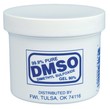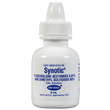Pronunciation
Deye-meth-il sul-FOKS-ide - Pronunciation guide
Brand Names
- DMSO 90%
- Domoso Gel
- Domoso Solution
- Synotic® Otic Solution
Description
Dimethyl sulfoxide is used to treat a number of conditions. With the ability to attract or absorb water, it can penetrate skin and other tissue, and carry other drugs into the tissues where the medication is needed.
Dimethyl sulfoxide has anti-inflammatory and mild antibacterial properties. It is FDA approved only for application to skin, but is often administered in other ways.
Usage
Dimethyl sulfoxide is used for emergency treatment of brain and spinal cord inflammation, endotoxemia, laminitas, and in the treatment of very sick, young foals. Dimethyl sulfoxide may be administered systemically, either by nasogastric tube or by intravenous injection.
The medication may be diluted with sterile saline to flush infected joints. It is used topically, both for its anti-inflammatory and antibacterial properties and as an agent for absorption of other drugs.
Dosage and Administration
 Dimethyl Sulfoxide Dimethyl Sulfoxide |
||||
|---|---|---|---|---|
| Method | Dosage | Concentration | Period | Duration |
| Topical | Up to 100 grams | 2 or 3 times daily | Up to 30 days | |
Notes:
|
||||
Side Effects
DMSO can cause skin irritation and blistering in horses through the release of histamines. Some horses show objection to DMSO because of pain and/or skin irritation.
Mild sedation and drowsiness may occur.
Intravenous DMSO can cause destruction of red blood cells. This can be partially avoided by slow administration and dilution in IV fluids.
Precautions
Humans should avoid contact with skin by wearing gloves when using product. DMSO should be used in a well-ventilated area. Some individuals have a pronounced systemic reaction to DMSO exposure with mild sedation and drowsiness. The manufacturer's insert should be read carefully before using the product.
Since DMSO will carry almost anything across the skin, care should be taken that extraneous or toxic compounds are not inadvertently carried into the body.
When first diluted for systemic use, DMSO undergoes a chemical reaction, releasing heat. The solution should be allowed to cool before using.
Systemic DMSO should be used carefully in animals suffering from shock or dehydration. IV fluid therapy may be necessary before and during administration.
DMSO is partially excreted through the lungs and may cause "bad breath" in animals and humans exposed to it.
DMSO has caused birth defects in laboratory tests and should be used in pregnant animals only when benefits outweigh the risks.
DMSO should be used carefully in older horses, especially in cases of liver and kidney function impairment.
Topical use of dimethyl sulfoxide is FDA approved for use with horses. Systemic use is not FDA approved, though many systemic uses are accepted practice. Medical grade DMSO is a prescription drug. U.S. federal law restricts this drug to use by or on the lawful written or oral order of a licensed veterinarian.
DMSO is a prohibited substance in drug-free competitions. It is important to check with the individual regulatory body regarding its use, especially since it has the ability to carry another prohibited substance into the body of the horse and inadvertently cause a drug violation.
Interactions
Effects of corticosteroids and atropine may be prolonged or increased by DMSO. DMSO should not be used with organophosphates.
Overdose
Overdose may result in mild signs of toxicity, including sedation and blood in the urine. More serious signs of overdose include difficulty breathing, seizures, coma, and death. All manufacturer's and veterinarian's directions should be followed carefully.
Images
 Domoso Gel
Domoso Gel
 Synotic® Otic Solution
Synotic® Otic Solution
Literature
